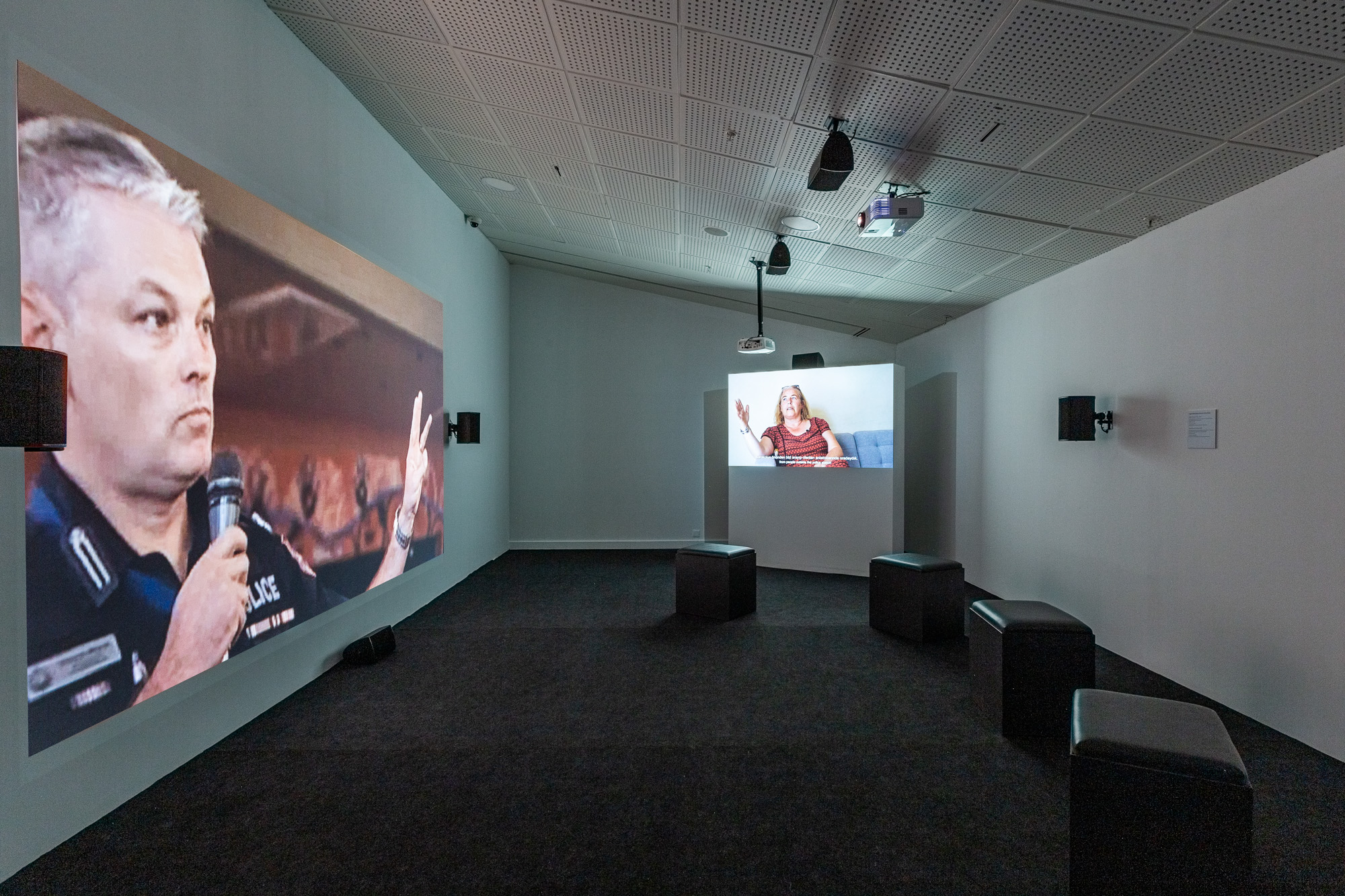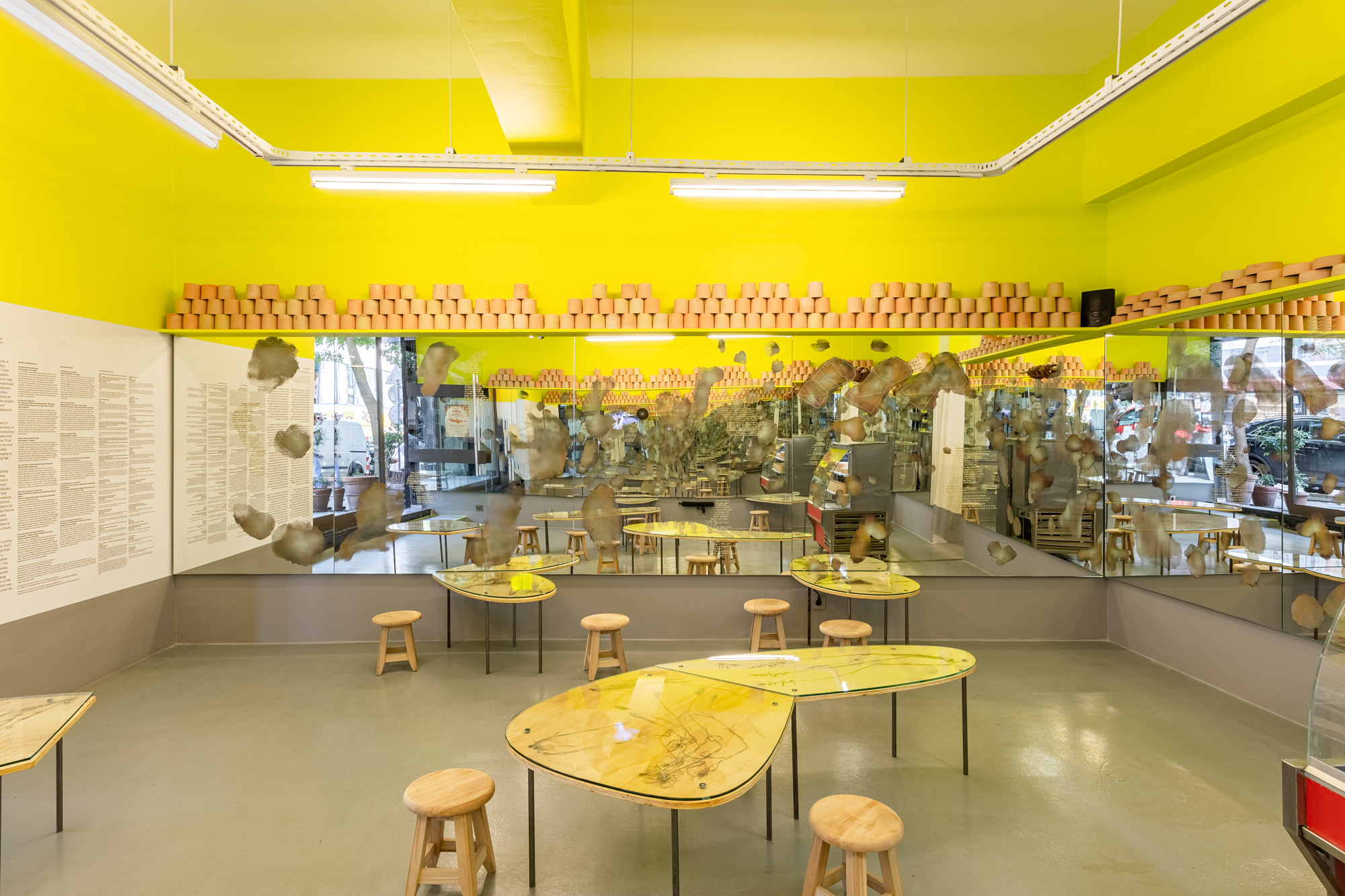Istanbul: 17th Istanbul Biennial
By Bala Gürcan
Full text also available in Chinese.

Installation view of ANGELA MELITOPOULOS’s Matri Linear B – Surfacing Earth, 2021, two-channel video and eight-channel sound installation: 75 min, at the 17th Istanbul Biennial, 2022. Photo by Sahir Ugur Eren. Courtesy the artist and Istanbul Foundation for Culture and Arts (IKSV).
Pushed back one year due to the Covid-19 pandemic, the 17th Istanbul Biennial was realized in an unprecedented time of disintegration for our accustomed communication, social, and economic systems. This significant breaking point between past and present models of living acts as the central axis of the Biennial, which seeks to develop a collective language of social healing, action, and resistance for the future. Instead of focusing on a single overarching theme, the curators Ute Meta Bauer, Amar Kanwar, and David Teh defined the Biennial’s process-based perspective as analogous to “composting,” enabling new concepts and definitions to grow, fertilize, and unfold beyond the event’s duration. Spread out across 12 locations around the Beyoğlu, Kadıköy, Fatih, and Zeytinburnu neighborhoods, the Biennial featured 55 projects with more than 500 contributors in myriad forms, from archival footage to audiovisual recordings, poetry readings, podcasts, live events, and an agricultural festival. In constructing a citywide network of artistic endeavors informed by planetary causes and focusing on creative communication methods, the Biennial opened up wider dialogues to highlight the power of community.
In an essay titled “Com-post” in the Biennial’s Afterthoughts catalogue, environmental philosopher Michael Marder defines composting as “a mode of composing, elaborating the grammars of existence, stringing together the letters and the words written in a biochemical language.” Exceeding the limitations of regular language organized by systems of power, the Biennial was instead concerned with the sounds in between, the subtle calls of nature, and revitalized discourses of solidarity. This was the case in artist Angela Melitopoulos’s research-based, multi-channel video project Matri Linear B – Surfacing Earth (2021), which provides documentation of Indigenous land struggles in Australia’s Northern Aboriginal territory of Titjikala, interspersed with footage of Indigenous artist Nita Fergusson in the process of painting her abstract desert landscapes in long bold strokes. Defining the Earth’s surface as a “speaking landscape,” Melitopoulos’s work questions the extent to which a reconsideration of eco-centric and matrilineal cultures can inform our contemporary views of land rights and the distribution of natural resources. The Biennial curators situate “elemental politics” as a starting point for radical reflection to thinking beyond dominant narratives of invasion, occupation, inequality, and repression.

Detailed installation view of IRWAN AHMETT and TITA SALINA’s Global Temperature Change Since the Industrial Revolution and Finding Artifacts – The Call of Fragility, 2022, multimedia installation, dimensions variable, at the 17th Istanbul Biennial, 2022. Photo by Sahir Ugur Eren. Courtesy the artists and IKSV.
The concept of “geopoetics,” which offers an alternative view of the universe and its non-human inhabitants as an indivisible whole, echoed throughout the Biennial. The great divide between nature and culture leads to the undermining of our complex relationship with the planet and its cycles. In The Call of Fragility (2022), shown at the Pera Museum, Jakarta artist duo Irwan Ahmett and Tita Salina invite us to reconsider our powerlessness in the great schema of the universe, examining ecological change over a very long time frame. Organized in two parts, the work consists of video footage that takes the viewer through fishing villages and caves in Java, and a tabletop installation of archeological displays such as stone samples and prehistoric animal fossils from the island, annotated with handwritten texts. A brass instrument placed in the same room captured vocal sounds made by visitors and blended the resonances together into a collective lament. The sense of transience emanating from the rare specimens of soil, plant, and animal life enables us to access the material wisdom embedded in the Earth’s remote layers. As Ahmett and Salina question our current understanding of time as a linear rather than a cyclical progression, their work was a reminder of our volatility in the natural world and our inevitable extinction from the perspective of a million years.
Similar to the way voices materialize and reverberate beyond the constraints of time and space in The Call of Fragility, A Dictionary of Sensitive Sounds (2019– ) by artists Evrim Kavcar and Elif Öner is an “anti-dictionary” that identifies and documents everyday sounds that are resistant to linguistic definition, such as “the sound of curtains flapping in the wind,” and “the sound of blood collection tubes in the hospital, tapping each other lightly while being transported.” Aptly exhibited at the Performistanbul initiative’s space in the form of a tabletop installation with books, objects, photographs and notes documenting the artists’ research across the city, alongside projected slides of various sounds descriptions, this ongoing project seeks to highlight the expressive potential of sound that has not been bordered by language. As they explore new territory in the domain of speech through the physical process of walking and gathering physical and sensory data, Kavcar and Öner expand the way in which we categorize auditory information that evades the net of recognition. Through this process, hearing turns into a social and participatory phenomena with space to express the previously unexpressed.

Installation view of COOKING SECTIONS’s Wallowland, 2022, site-specific multimedia installation, dimensions variable, at the 17th Istanbul Biennial, 2022. Photo by Sahir Ugur Eren. Courtesy the artists; IKSV; and contributors Akgun ilhan, Anadolu Meralari, Burcin Cingay, Itri Levent Erkol, Melisa Bal, Mustafa Avci, and Gulinler.
The idea that new sensory experiences and inputs can radically reconfigure our understanding of the world and its current struggles was also manifested in Wallowland (2022), by the Turner Prize-nominated studio Cooking Sections. The loss of Istanbul’s wetland habitats due to urbanization threatens the city’s endangered population of water buffalos. Through the contributions of herders, biologists, conservationists and others, the first annual Water Buffalo Festival took place on September 17 in Istanbul’s outer Arnavutköy district along the Black Sea coast, with guided walks and workshops, live music and food tastings. At a Biennial site, Cooking Sections redesigned the gallery space of Büyükdere 35 as a pudding shop featuring water-buffalo milk products such as kaymak (thick cream) and muhallebi (milk pudding). By offering visitors a tasting session of these products, Cooking Sections adds a personal and tangible dimension to an ecological crisis involving the animal’s risk of extinction as well as related culinary traditions.
One of the curators’ primary ambitions in the Biennial was to “expose every project to new publics, new audiences; to arouse new critics, new sympathies and new solidarities.” To that end, several projects such as Radyo Bienal, realized in collaboration with Açık Radyo, an independent radio station associated with climate awareness and local activism, and the Turkey-based Poetry Channel, with 15 commissioned poets who wrote one poem for each month of 2021, were designed to outlast the Biennial’s physical presence. The poems can be encountered in various locations across the city such as bookstores, restaurants, and coffee shops, and were also broadcast through Açık Radyo podcasts. Featured in this collection, for instance, Haydar Ergülen’s poem Kayıp Keçi Miki (“Lost Goat Miki”) describes the melancholic sentiments aroused by revisiting simpler times in the past through a reference to animals such as goats, pigeons, and horses. Whether traveling in the form of words or sound waves, a poignant taste or a whole-body experience, the information that is required to revitalize the world comes to us from many different directions. The Biennial asks us to open our senses and pay attention.
The curators’ interwoven and multilayered approach pushed the bounds of the Biennial outside the realm of visual arts, involving other arenas such as media, literature, science, technology, and academia. With an idealistic outlook supported by a deep commitment to research, Meta Bauer, Kanwar, and Teh did not reject previous models, developments, or perspectives but instead promoted an acceptance of them as necessary ingredients in building a new, sustainable order beneficial to all life. By thinking from the local scale up—in terms of the context of works, the show’s organization, and its broader effects—the Biennial gives shape to the maxim that the world is a big village, with its long strands tying all of us together. So rather than pointing fingers at institutions and finding culprits for the world’s socio-economic and ecological disparities, the curators offered possibilities for a fresh start, not from scratch, but with the individual parts of a world we collectively built. They ask us to make use of the ground we are currently on, to plant new seeds to ensure the growth of a sustainable life.
.jpg)






